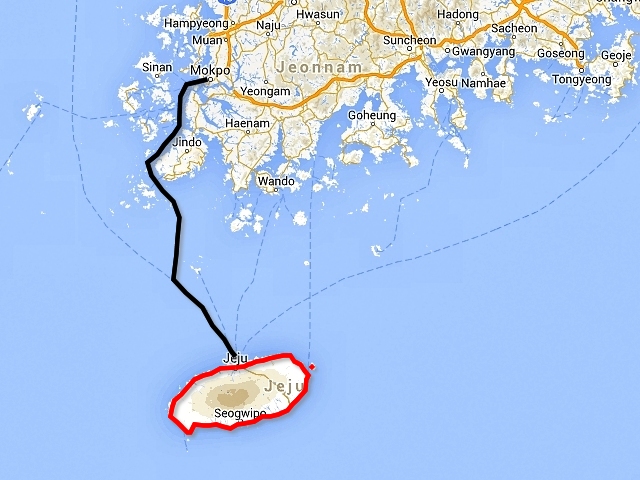
Nothing compares to the simple pleasure of a bike ride. J.F.Kennedy
Search this website
Jeju Island
Jeju, Aewol, Hallim, Gosan, Wolpyeong, Seogwipo, Pyoseon, Goseong, Seongsan, ostrov U, Sehwa, Woljeong, Jeju
My Usual Luck
I doubt if anyone would have heard of Jeju Island if it had not been for the infamous 2014 ferry catastrophe reported in the global media. The island is a very popular destination for Koreans, so I believed I would also enjoy it. A few days before, I had read some information that the ferry to the island departed daily at 10:00. I rose at sunrise at 6:00, there was plenty of time left. After a proper wash and modest breakfast, I slowly strolled through the city to the 10 km distant harbor. I reached the harbor at 8:45 and found that the next ferry departed at 9:00. I managed to board it, only could not get on to the car deck, as it was already closed. I removed my panniers, a crew member helped me to carry the bicycle up the gangplank on to the ferry and then we took everything down to the lower deck. I was to exit the ferry with the cars. Bicycles were not tied to the side, instead they were laid down on the deck.
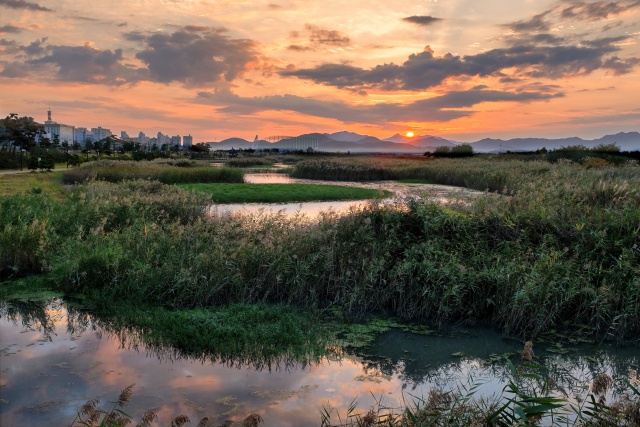
Mokpo: I watched the sunrise from the pavilion under which I slept

Mokpo: High-speed ferry in the harbor
The voyage from Mokpo by Sea Star Cruise took nearly 5 hours. There were also faster options (and more expensive) – Pink Dolphin would only take 3 hours and 10 minutes and Royal Star ferries only 2.5 hours. The first hour of the cruise was the most interesting. The ferry sailed past an unbelievable number of various sized islands. I was not the slightest surprised that this route was considered dangerous in bad weather.

Ferry Mokpo - Jeju: Ferry sailing through the archipelago
The ticket included a berth in a cabin. The cheapest ones – tourist class – were fitted only with mats. However, there were also electrical sockets, so one had the possibility of charging various devices. Most people left their devices charging unattended and walked around the ferry, which had both a restaurant and a small store, where meals for microwaving could be purchased, or alternatively, several types of instant noodles. Of course, hot water as well as microwaves were available. The most popular was the obligatory soju and Korean draught beer. Apart from food, one could use the other available forms of entertainment: sing karaoke with friends or play the slot machines. The voyage then passed quite quickly.

Ferry Mokpo - Jeju: Men watching baseball in the main lounge
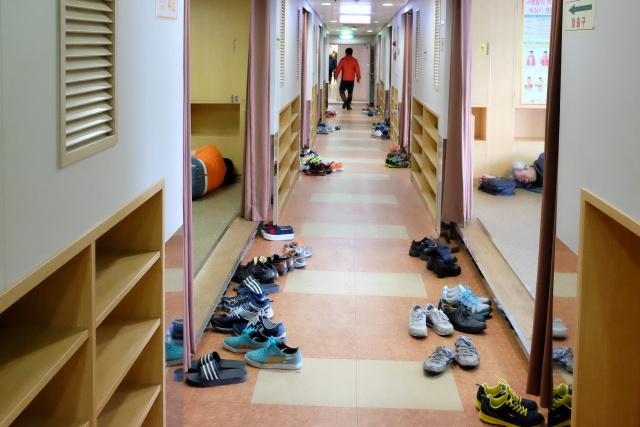
Ferry Mokpo - Jeju: Shoes outside economy class cabins
Jeju Island
Jeju is an egg-shaped volcanic island with Halla, the highest Korean mountain (1950 m), right in the center. It is very rare to see the mountain, as it is usually covered in cloud or hazy fog. The island is said to be similar to Hawai and Bali. There are many stone structures – stone piles and stone bulwarks separating individual little fields. Just as on the Polynesia Islands, a culture of stone statues was created there. The local variant, called Hareubang, has bulging eyes with hands placed on a full belly. Their purpose is not known; some sources claim they are connected to the past Mongolian colonization of the island. The statues are literally everywhere, but only 45 of them are original, mostly in Jeju City.
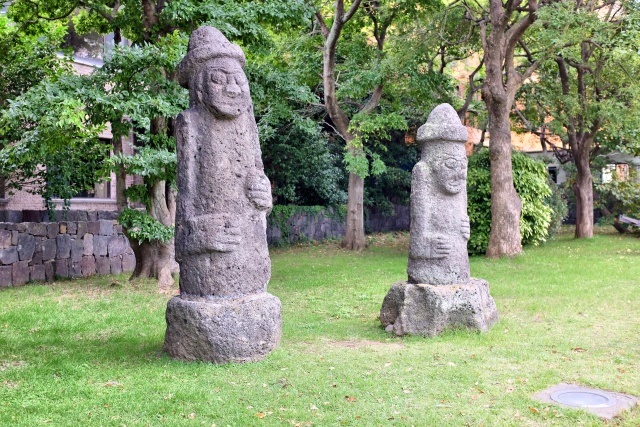
Jeju (Jejumok - Gwana): A total of 45 hareubangs are original, well-preserved statues
The island is also popular with cyclists, who usually cycle around it lightly loaded, typically for 3–5 days. I met many of them, some of them repeatedly. They were very friendly, always trying to offer me a snack. In order to be able to return the favor, I bought some mandarins and could at least return their sweets with some fruit.
I was disappointed on only one occasion. When I was returning to Jeju City, I again came across four cyclists. I was in a good physical condition, so I overtook them and cycled ahead. Then, after several kilometers, I waited for them again. I met them for the last time in Jeju, when I could not locate a hotel which was rated with good references. I thought they would help me, but they said they did not know the place either and ignored me. Nevertheless, one of them could speak a little English. I asked him to ask the local people for directions on my behalf, but he was not interested in helping me. I should not have raced them so much.
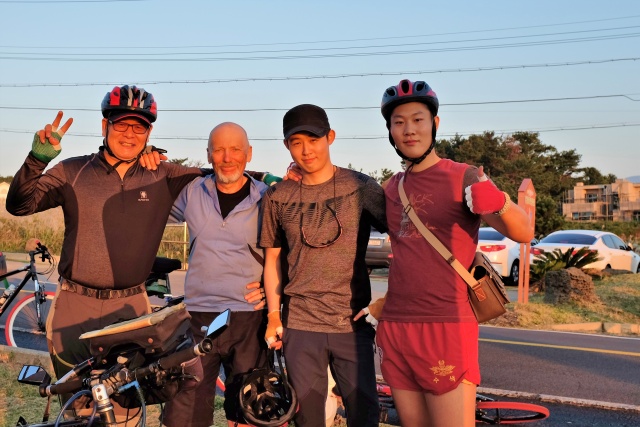
Gonae: With Korean cyclists at nightfall – they were about to continue for another 3 hours
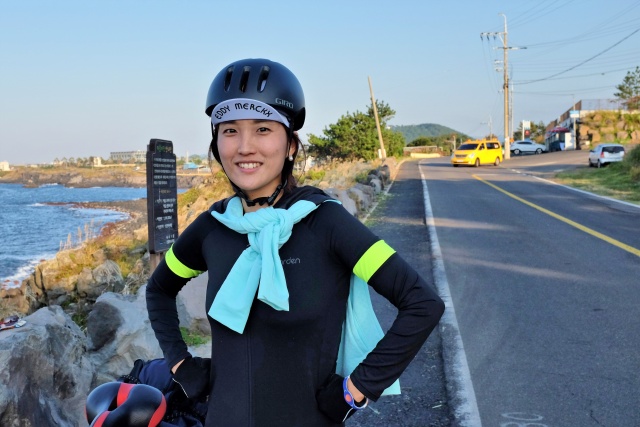
Gonae: Korean cyclist I'd encountered a few times previously
For the first night on the island I found a nice place to sleep, on a promontory above the sea, with toilets and running water, benches and shelters. I needed to charge my camera and Kindle, but I was not too keen to leave them charging unattended in the toilet. So I closed one toilet cabin from the outside, then made sure I could also get in, and left my devices charging in it. The toilet cabin looked as if it was out of order. There were also two others, so there was no reason for anyone to try to get into that one. Then I went to admire the sunset. When it was completely dark, a string of powerful lights on the horizon came on. Had I been in the North, I would have guessed it was security border area protection against Korean communists. But on Jeju the explanation was prosaic – it was fishermen using the powerful lights to attract calamari into their nets.
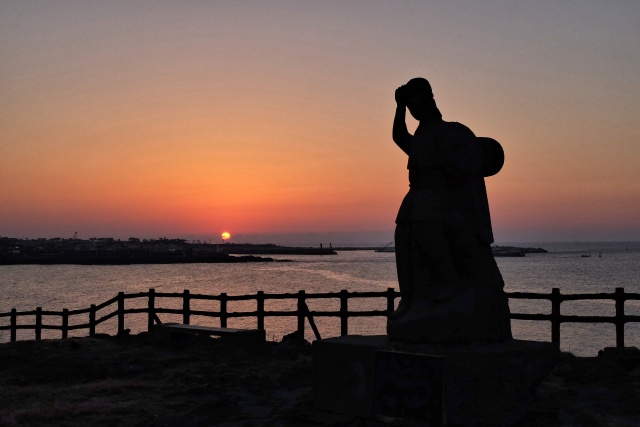
Gonae: Sunset
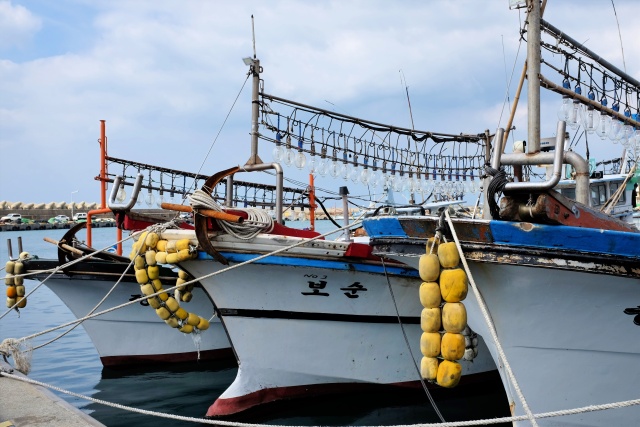
Daejeong: Boats with lights used for catching octopus
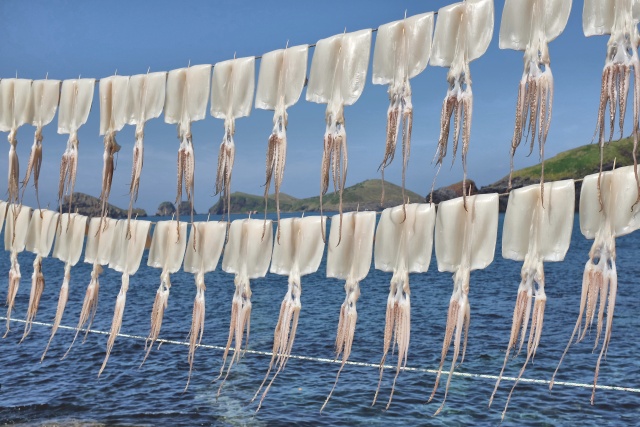
Gosan: Dried calamari
The excursion around the island was enjoyable. The countryside was interesting, always changing, sometimes with a small hill. All the time, there was a strong "righteous" wind blowing from the back, side or front, depending on the position I was in on the island. It was possible to cycle on the local roads with little traffic along the shore. Bigger roads were equipped with a separate bike lane, therefore it was safe even in heavy traffic. However, the lane was also used by parked cars, people drying seaweed and other crops they cultivated in the fields next to the road. Cycling close to the sea was the best. I could see many birds and had the opportunity of observing a shoal of dolphins for some time, leaping over the waves near the shore.

Aewol: Harbor
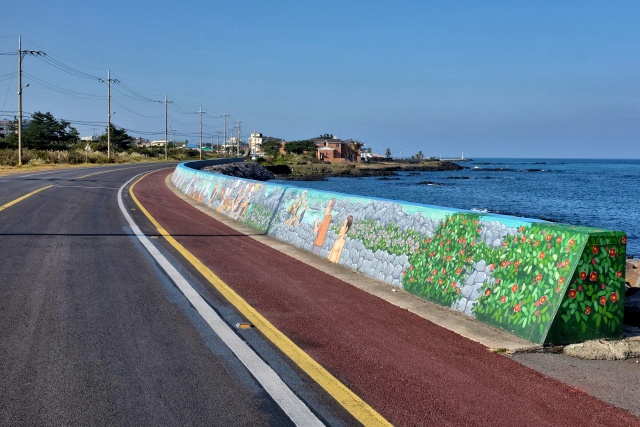
Hallim: Painted wall along bike path
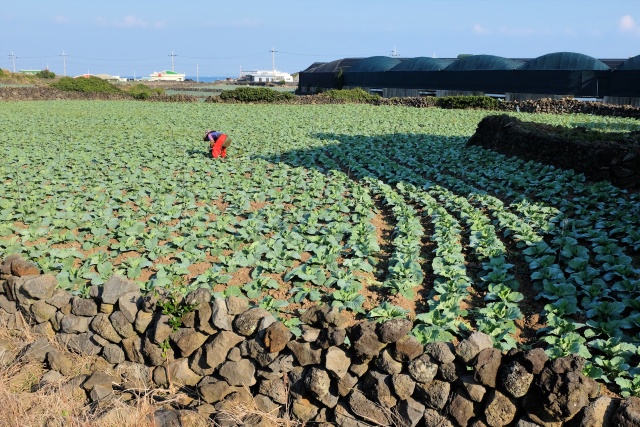
Aewol: Work in the field

Gonae: Typical stone buildings scattered all over the island
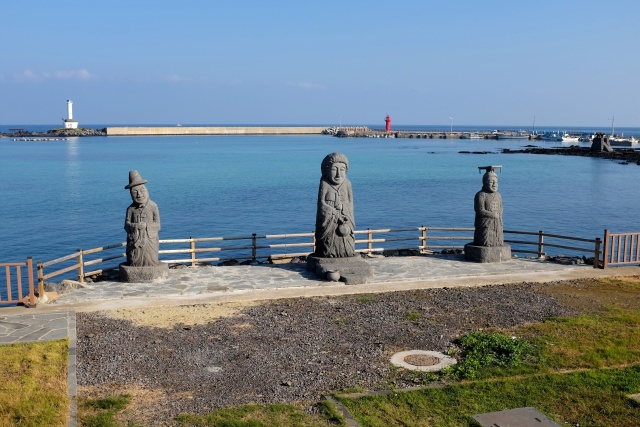
Gwideok: Harbor statues
There was no point in chasing kilometers or rushing anywhere. It was a much better option to enjoy the scenery and the unusual stone artifacts with the many hills, valleys, waterfalls, caves and other tourist attractions – museums and theme parks. I was interested in seeing the huge Yakcheonsa Temple, with supposedly the biggest indoor hall in the whole of Asia, yet of no real historical importance as it was built in 1990.
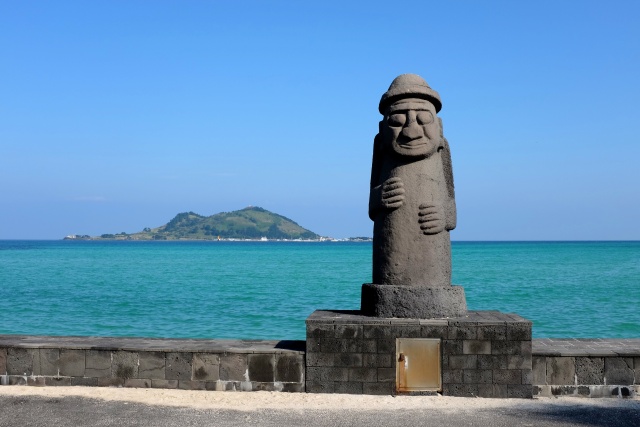
Hyeopjae Beach: Biyangoo Island in the background

Gosan: Several small islands on the coastline
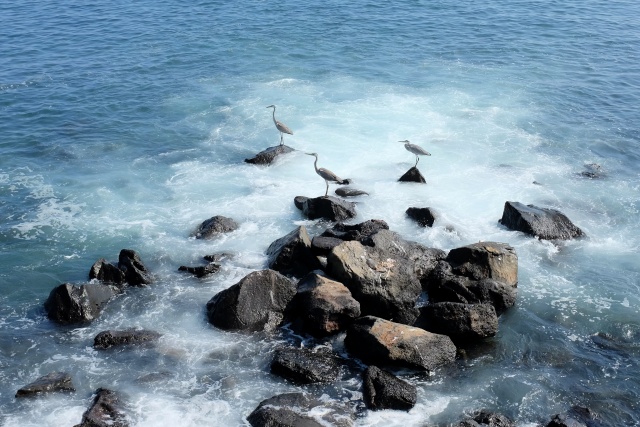
Sindoi: Egrets
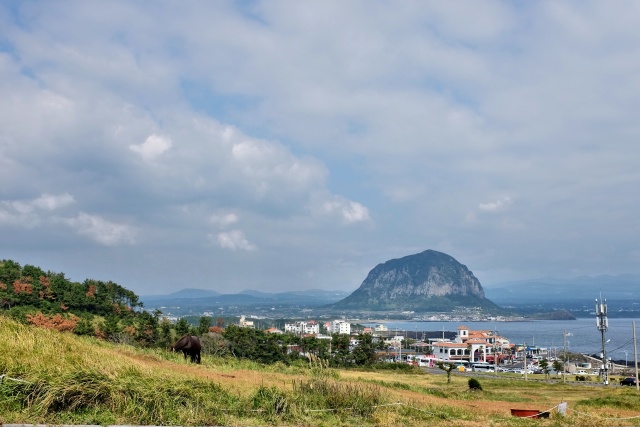
Sagye: Sanbangsan Mountain in the background
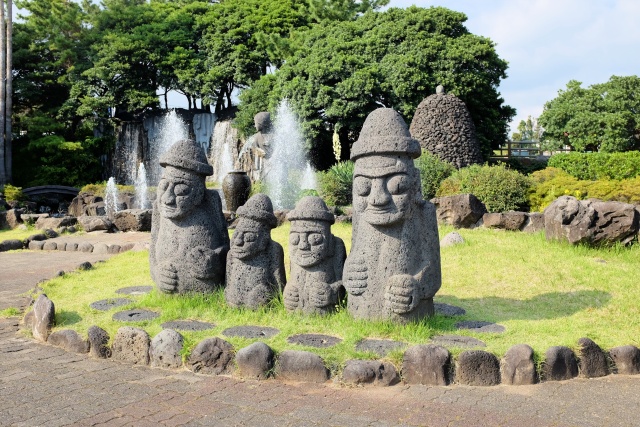
Jungmun Resort: Some hareubang statues
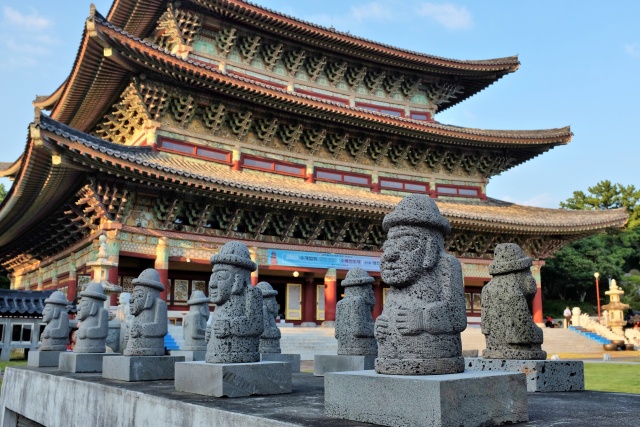
Wolpyeong: Yakcheonsa Temple
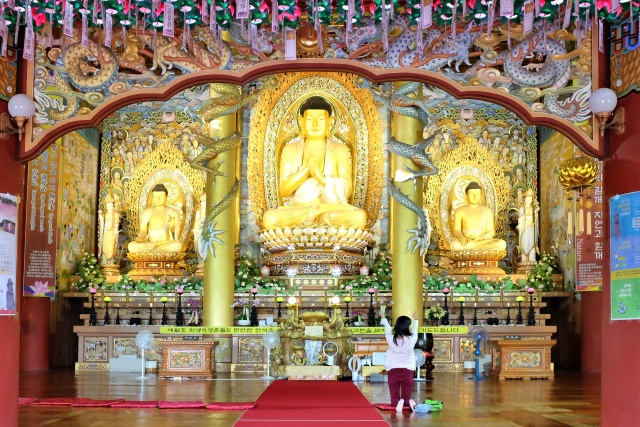
Wolpyeong: Yakcheonsa Temple
It was getting dark on the outskirts of the second biggest town – Seogwipo. It did not seem like a place for sleeping "in the wild", no open areas, all the fields planted with crops. Suddenly I saw a sign to Choenjiyeon Waterfall; I hoped that there would be something there. However, before reaching it, I came across a parking lot at the Oedolgae Rock exit. The only problem was food, I had not eaten for the whole afternoon. The stall in the parking lot only sold sausages, so I had no choice but to eat at least this unhealthy snack in order to still my acute hunger. I pitched my tent on the grass in a shady spot in the parking lot, and all was well. Apart from myself, there were also other people sleeping in four cars.
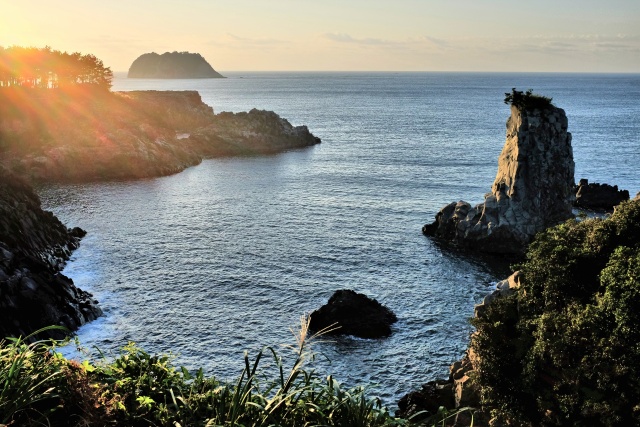
Namseong: Oedolgae cliff on the right
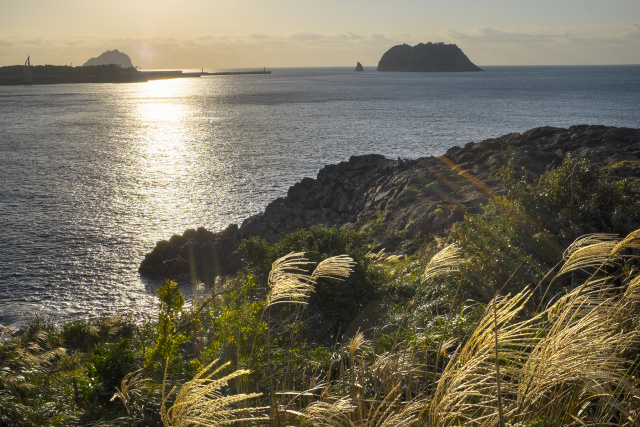
Namseong: Sunrise
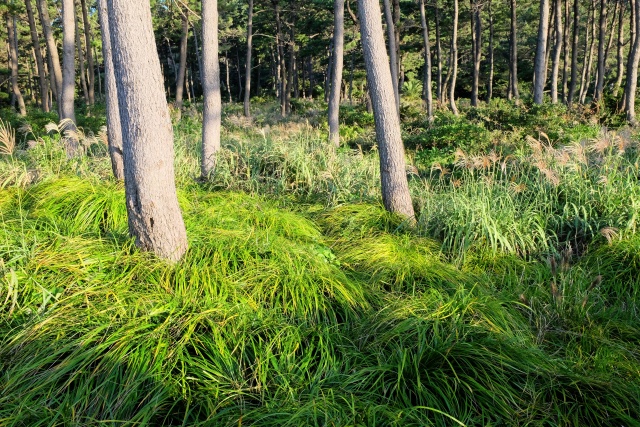
Namseong: In the forest
Jeju Folk Village Museum
On my empty stomach, I took a stroll in the forest at sunrise. I was pleased by the view of Oedolgae Rock, called "The Gigantic General" for historical reasons. Then I cycled 2 km to Choenjiyeon Waterfall, located right in the town of Seogwipo. I could not postpone the visit to the market any longer to get some proper food from the market ladies. I had to catch up on the deficiency from the day before, and stoke up with supplies for the future. Who knew how I would end up that night? My main destination was Jeju Folk Village Museum, exhibiting over a wide area in a pleasant series of forest houses, agricultural village, fishing village, aristocrats' homes, temple, shamans, church buildings and stone artifacts. It was very interesting, yet only a few structures were original, otherwise everything else had been newly built.
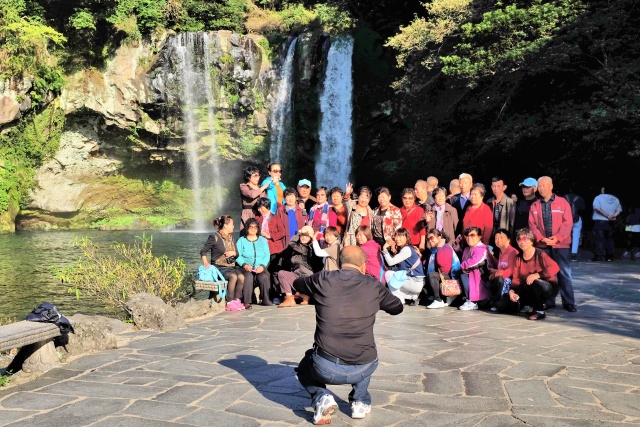
Seogwipo: Group photo in front of Choenjiyeon waterfall
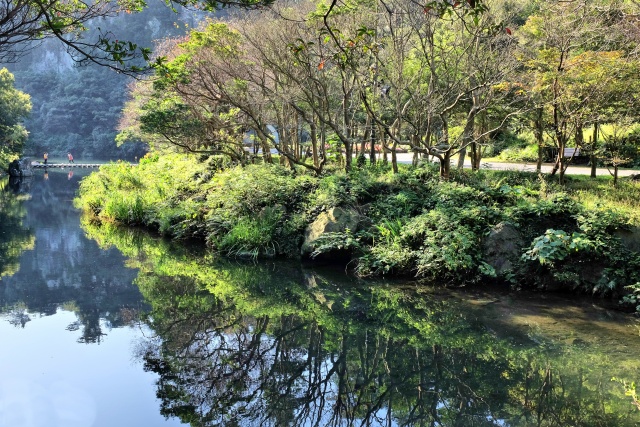
Seogwipo: Downstream from Choenjiyeon waterfall
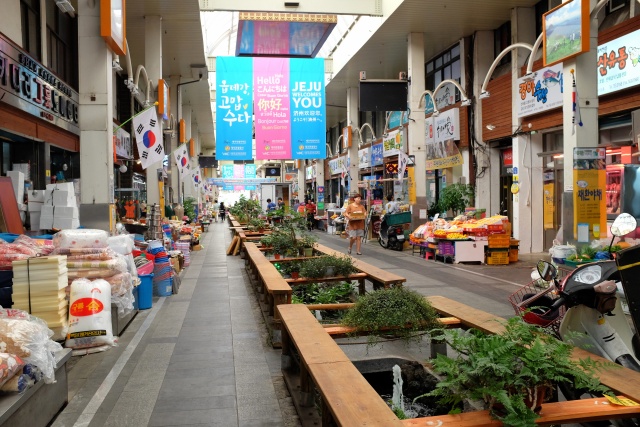
Seogwipo: Water flowing through the middle of the marketplace
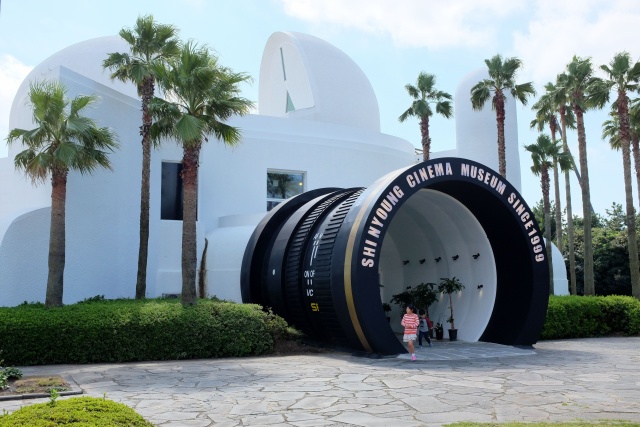
Shinyoung: Film Museum
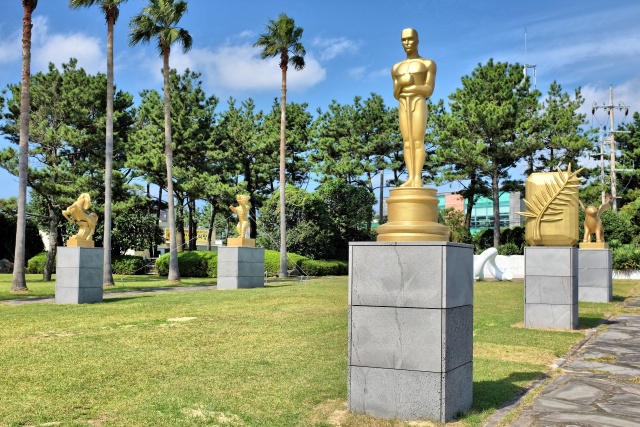
Shinyoung: Oversized film festival trophies
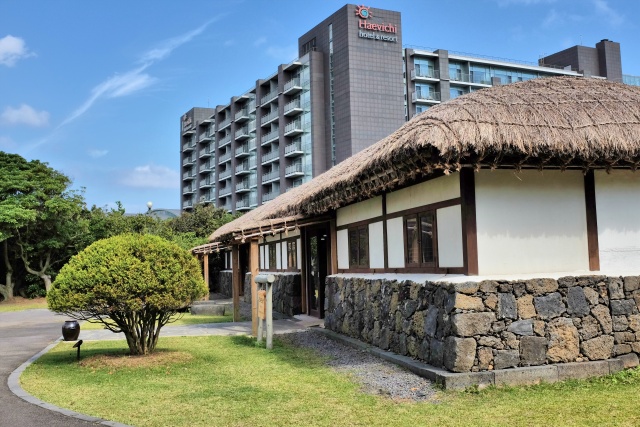
Jeju Folk Village: Open-air museum in the neighborhood of modern hotels
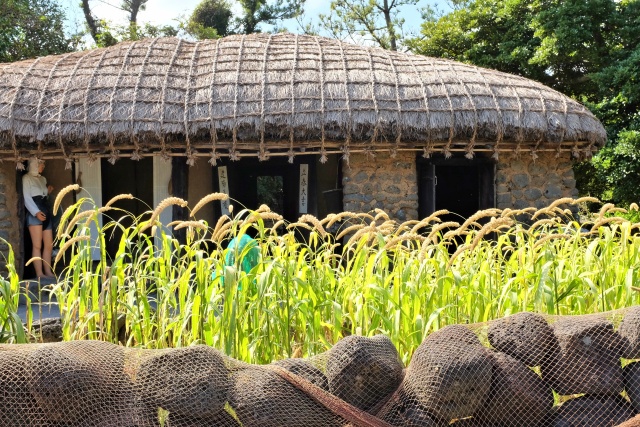
Jeju Folk Village: Farmhouse overgrown with rice plants
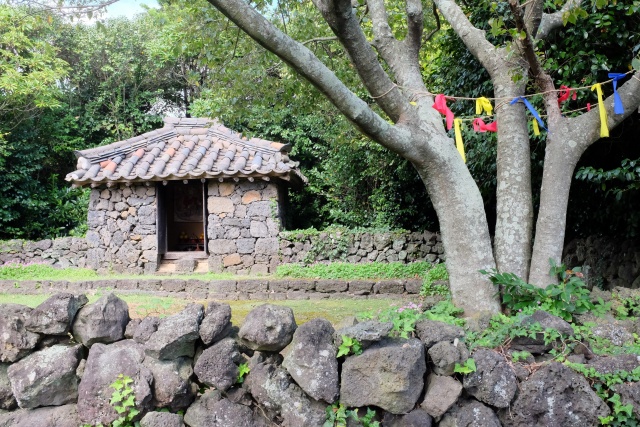
Jeju Folk Village: A little sanctuary
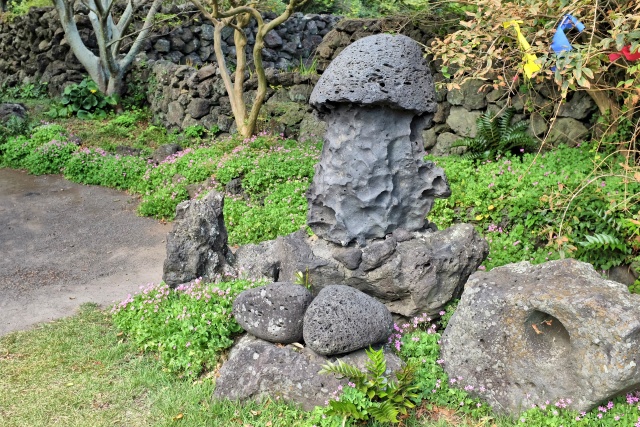
Jeju Folk Village: Namgeunseok – to whom women pray when they want a son
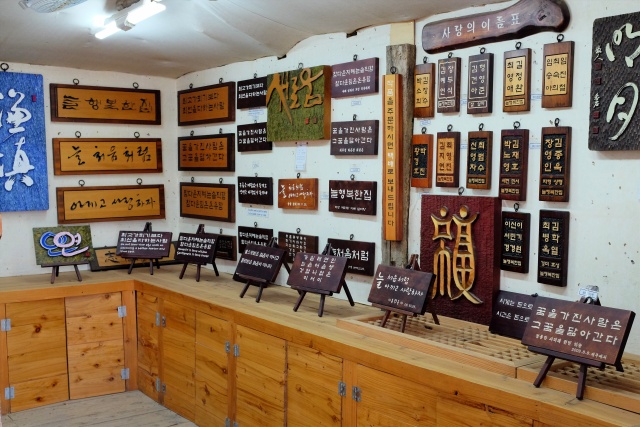
Jeju Folk Village: Calligraphy workshop

Jeju Folk Village: Painter teaching children how to handle the brush
Seongsan Ilchulbong
I wanted to sleep over on U Island, this is why I speeded up slightly, pedaling a bit harder against the strong wind. I had missed the ferry anyway and the next one was not departing until the following morning. The same fate overtook another group of cyclists who, moreover, could not find accommodation, everything was fully booked in the vicinity. They asked me how I was going to solve this problem, so I only indicated my tent bag and said that I would find a camping spot somewhere. It was still light, so I decided to go to the peak of the popular Ilchulbong, by the way also UNESCO-listed. It is of volcanic origin, the summit is overgrown with grass and bushes and receives the first sun rays on the island. It is very popular on New Year's morning, when it is totally packed and one can hardly move. Even during my visit – a working day – it was quite full of people. This 182-meter high hill can be reached by quite convenient steps. It is a nice walk up, past interestingly formed rocks projecting from the hillside.
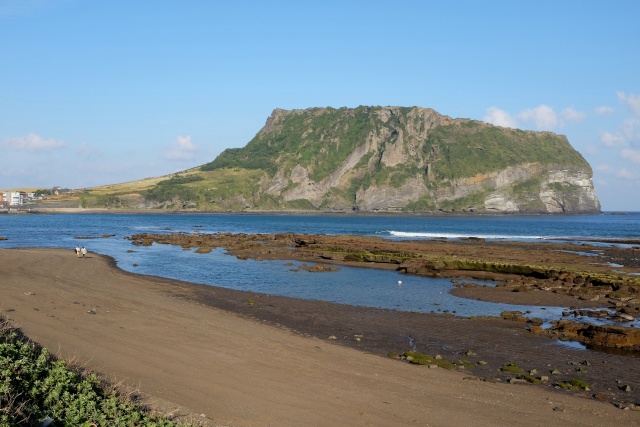
Seongsan: Ilchulbong Hill
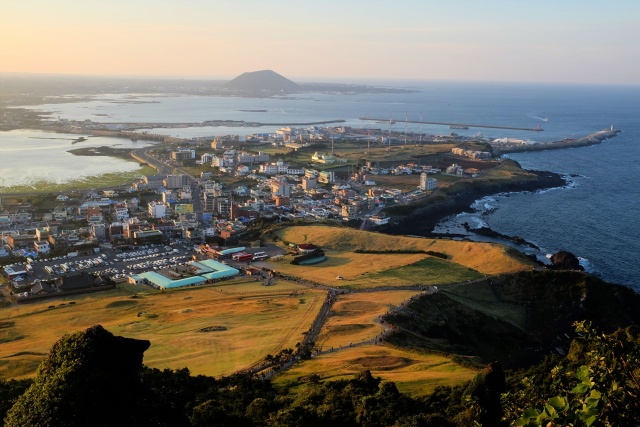
Seongsan: View of Seonsangu Harbor from Ilchulbong Hill
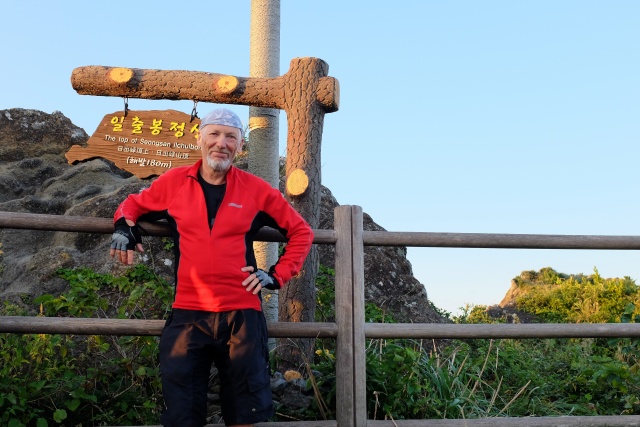
Seongsan: Mandatory hilltop photo
U Island
I had no great luck getting to sleep – a small park close to the harbor had everything I needed. However, after midnight heavily loaded trucks started arriving at the harbor. When I had just fallen asleep again, a drunk entered the park at 03:00 and for half an hour his radio blared out some worn-out Korean songs. Furthermore, it was quite hot and, in addition, I was bitten by very tiny, yet aggressive ants. Only covering myself in repellent from head to toe helped. I did not sleep much that night, but on the positive side, boarded the first ferry the next morning. The trip to U Island took 15 minutes, with several ferries constantly shuttling back and forth during the day. Lines of people were formed in the harbor for this ferry. The island seemed to be very popular.
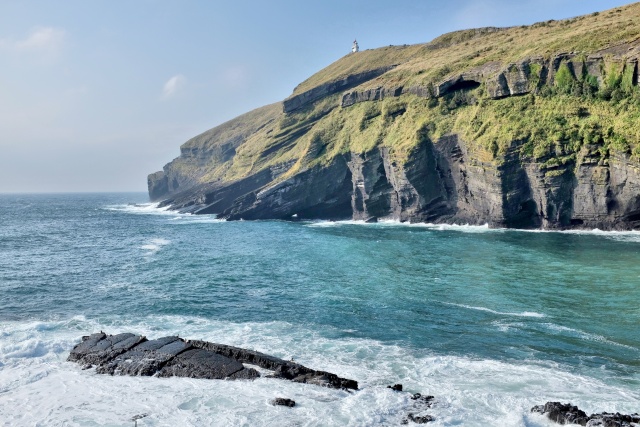
U Island: Hu-Hae-Seok-Byeok cliff
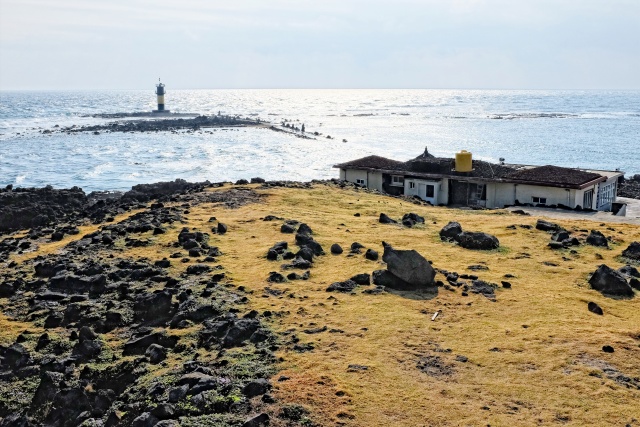
U Island: Lighthouse on Biyangdo Island
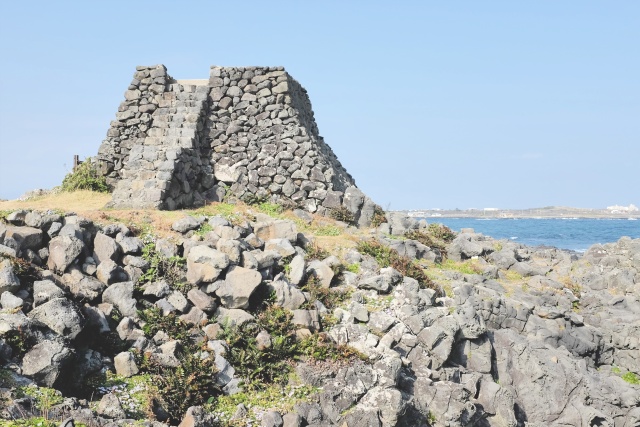
U Island: Mangdae watchtower on Biyangdo Island
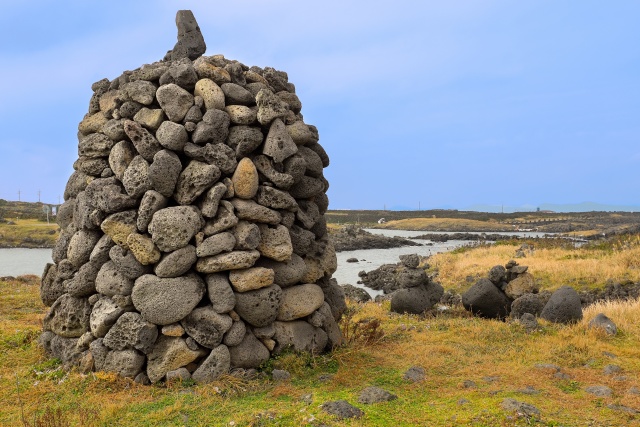
U Island: Stone mound
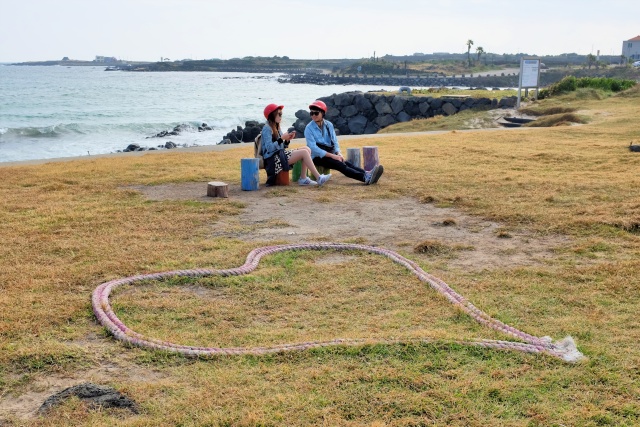
U Island: On Hagosu-dong Beach
It was worth it. U Island has a unique atmosphere and two beaches with white sand, quite dirty at the end of the season. The road around the island is 15 km long and it was crammed with people on rented scooters that morning. As it was getting quite crowded, I boarded the first ferry to Jeju City after completing a circuit around U island. The wind was blowing as on all the previous days, this time from behind and so giving me proper assistance. I enjoyed the small towns and harbors, as well as the cheap delicacies at Sehwa Market. For the first time, I also tried round slapjacks baked on a baking sheet. They had a sweet-spicy filling, which looked and tasted like chocolate with a sharp dose of chili. Wow! I stuffed myself!

U Island: Diver statues (haenyeo) on Hagosu-dong Beach
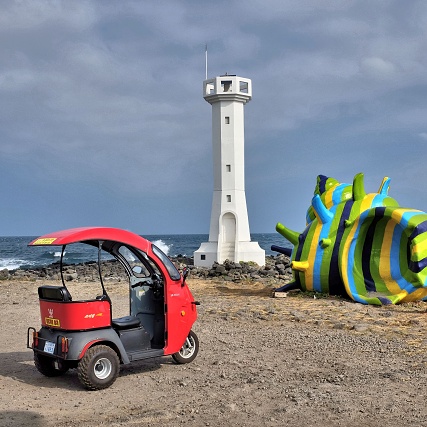
U Island: At the lighthouse
By early evening, I reached Jeju, getting slightly lost while searching for the recommended motel, which turned out to be full anyway. Instead I stayed in a nearby cheap hotel which was advertised as being for cyclists. OK, it had a big storage space for bicycles, together with a workbench and a pump. Otherwise nothing special, but most importantly it did not have WiFi, which I had forgotten to check on. I would have to go into the city with my laptop.
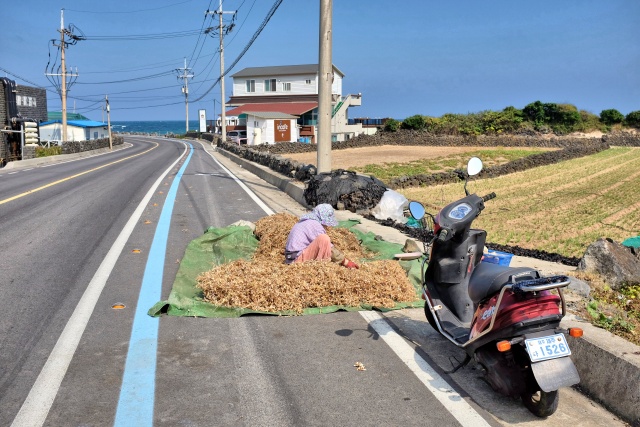
Near Sehwa: Woman processing a crop on the bike path

Woljeong: Children on the surfing beach
Service Day in Jeju City
The main reason for the one-day break was to wash and dry most of my clothes. I could not locate any American-style laundromat, where everything can be washed and dried within an hour. Instead it took a whole day and night for my hand-washed clothes to dry in the bathroom. Even so, I had 2 clotheslines and 12 pegs. I would have preferred to have the clothes washed properly, but it was rather difficult to find a laundromat and they were not suitable for dry-cleaning. The weather was 'suitable' too – abominable, windy, cloudy with showers. I found out at the harbor that the ferry would depart for Mokpo at 16:30 the following day, as it was a Sunday, instead of at 17:00 as scheduled for all other days. It was a good thing that I already knew where I could pitch my tent in Mokpo. I would easily cycle those 10 km through the city even at night.
I even visited the historical sites, although the city did not have that many. It was a pleasant, peaceful walk through the former Jejumok Gwana Governor's residence — a Palace located almost in the city center, creating an oasis of peace, where there were mandarins ripening at the time of my visit. Politicians already had it made back then. The Governor had his home with his official concubines right next to the Palace. Across the street was another house where his 'slaves' lived, always available – actors, artists, women. And in order to maintain his concessions, he also had soldiers living there, protecting him at all times. I took a liking to the pavilion, from which the dignitaries always bowed towards the North, in other words towards Seoul, where the Royal residence was located.
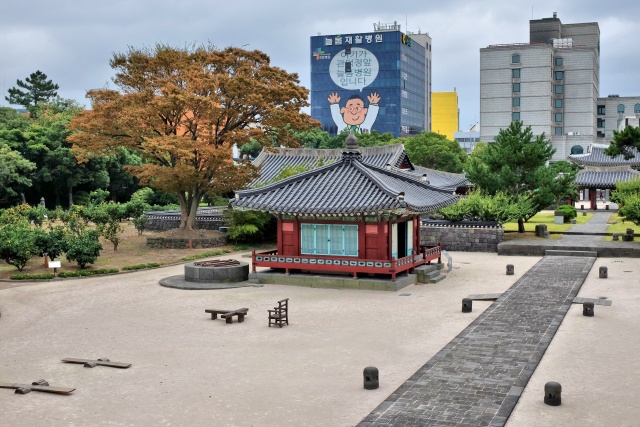
Jeju (Jejumok - Gwana): Governor's former residence is currently in the middle of a – rather ugly – city
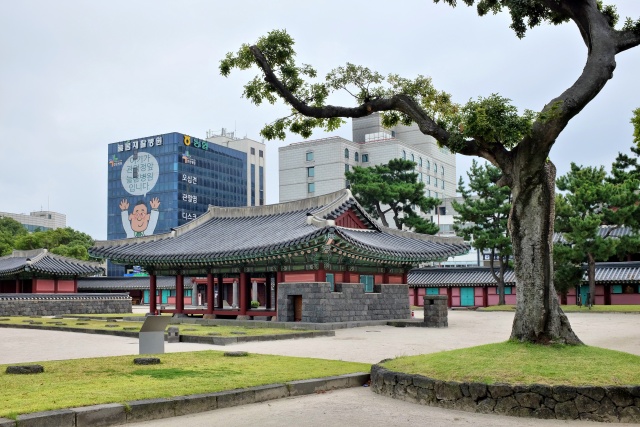
Jeju (Jejumok - Gwana): Former residence of Jeju Provincial Governor
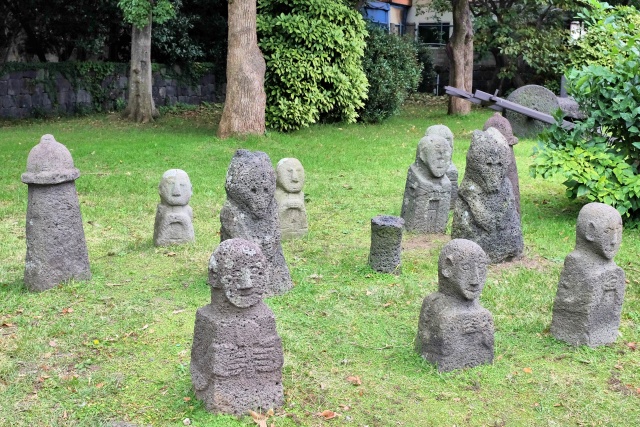
Jeju (Jejumok - Gwana): Child statues are rather rare
Samseonghyeol was the next 'obligatory' stop, quite popular among Koreans. If you pardon me, it is a pit in the ground, containing three holes – but these cannot be seen, they can only be seen in photos. From these holes arose three demigods: Go, Bu and Yang, who populated the island. Other sites are connected to the island's demigods – for example, where they met three princesses, where they shot three arrows to prove their occupation of the island, etc. These places are marked by stones in the countryside, with Korean signs. Tourist coaches stop at these sites, so that passengers can take selfies on their smartphones next to the stones. By the way, camera stores are quite rare in Korea, I only saw some in Seoul, sometimes represented only by one desk in a shopping mall.
Back to Samseonghyeol. From the photos exhibited, I found from which angle the holes in the ground could be seen. But the view was made impossible by a high stone wall, which was not possible to scale and I would not even have dared to do that, out of respect. I used my pocket tripod, set the camera's self-timer, set the manual focus approximately and took a chance photo. A flip LCD would have been useful.
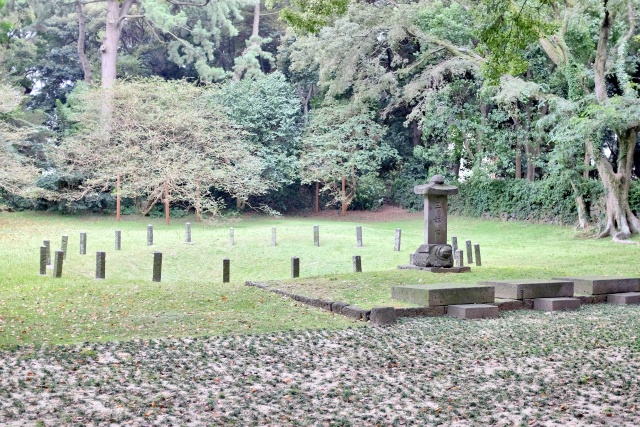
Jeju (Samseonghyeol): In the depression surrounded by poles are the 3 holes through which the 3 demigod founders of the city surfaced
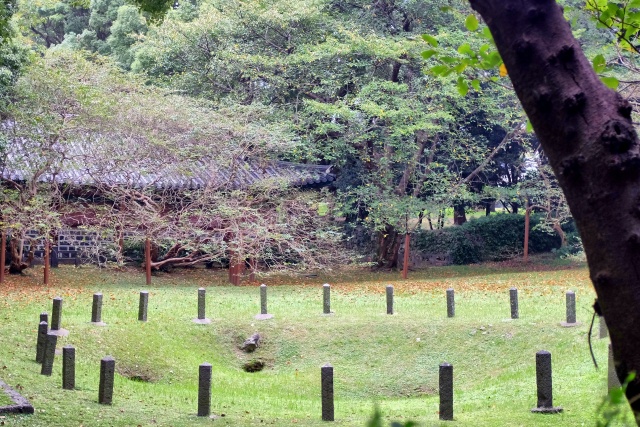
Jeju (Samseonghyeol): The holes, through which the founders of the city surfaced, can be seen only through a high fence
Man Proposes, the Weather Disposes
The plan for the following days was clear. On the Sunday afternoon, ferry to Mokpo, sleep over in the familiar park shelter and then continue to Busan on the following days. There I was to decide if I would fly to Taiwan from Busan, or if I would transport myself by ferry to Fukuoka on the Japanese island of Kyushu, cycle to Kagoshima and travel from there by ferry to Okinawa. From Okinawa, I would have no choice but to fly to Taiwan. Five years before, I had already taken this route from Fukuoka to Kagoshima. This time I wanted to take a different route. I was attracted to Okinawa.
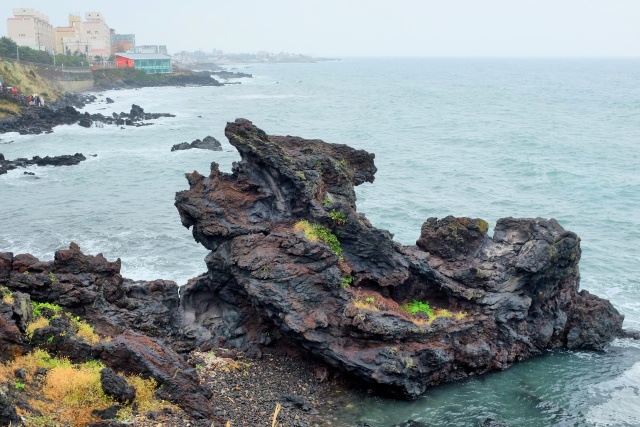
Jeju: Yongduam – dragon head rock
The ferry departed at 16:30 on Sundays, 17:00 on other days. I had plenty of time, so I spent the morning in the motel and left after 10:00 in persistent rain and an extremely strong wind. Nevertheless, I wanted to check out Yongduam, "Dragon Head Rock", which is very popular in Korea and very often used as a background for wedding photos. Then I wanted to set off for the 15-km distant Iho Taewoo Beach, to spent the time meaningfully before the ferry departure.
The weather was truly terrible! The wind made such big waves that water was splashing over the barriers on to the road. Jets of seawater were splashing from the city sewage system on to the coastal road."Oh my!" I thought to myself, "I'll probably be sick on the ferry!" – I'd had bad experience with seasickness in the past. There was an Information Office at Dragon Head Rock, so I asked whether the ferry would be sailing at all. The ferry had not left Mokpo on the two previous days, there had been a typhoon at sea. The following day, the ferry would definitely not be arriving, according to the weather forecast and the first real possibility was the day after that, if the weather was calmer.
"I'm not going to sit in Jeju," I thought to myself. Then I heard the roar of a starting aircraft and it was clear – I would fly directly to Taiwan. I cycled to the nearby Airport. Asian Air did not have any flights to Taipei. Korean Airlines did, but departed from Jeju to Gimpo (Seoul's second airport), from where I would have to transport myself with all my luggage to Incheon Airport and then fly to Taipei. Bad news – but the Internet was at hand, as the Airport provided free WiFi. I entered my request on Letuska.cz and the next day I was to fly with China Eastern Airlines to Shanghai and then, two hours later, on to Taipei.
I returned to the city, found accommodation, got hold of a box for my belongings, purchased two rolls of tape. As it was a Sunday, I could not get hold of my favorite roll of shrinkwrap. Instead, on the market I purchased about 10 meters of strong transparent foil, most likely intended to cover tablecloths. I would fix everything somehow at the Airport.
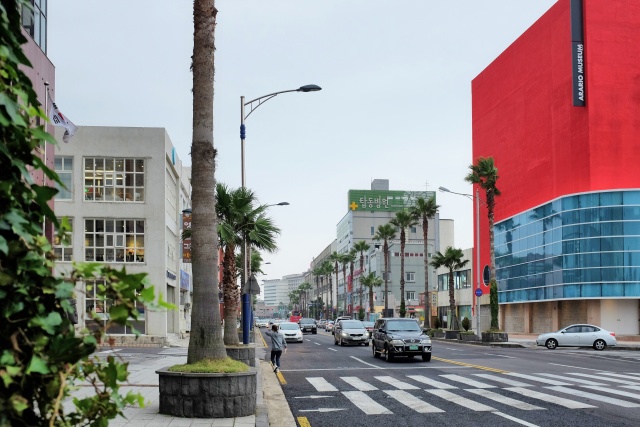
Jeju: Avenue in the center
Everything Changes
I had a constant nagging feeling that something was not right. I tried to figure out what it could be and then suddenly realized what it was! I had read somewhere that a visa-free stay in Taiwan could not be longer than one month. I checked it again on the Internet and I was right. Before entering Taiwan, one needs to display a confirmed reservation for a departing flight from the island. According to the Taiwanese immigration office, it is strictly controlled and there are no exceptions. I would not be able to meet this stipulation. My return flight was scheduled for November 26. I had no choice but to cancel my newly issued ticket and to forget about Taiwan. Although I could have changed my return flight from Taiwan to the Czech Republic to an earlier date, I was not so keen on doing that. Why should I shorten the thus far successful trip?
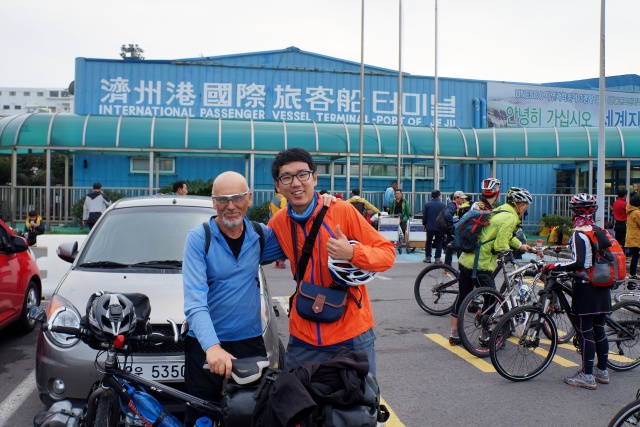
Jeju: With my cyclist friend before the Jeju ferry crossing – he gave me the title of 'strong man'
Back to the Mainland
It rained persistently during the morning. I did not need to travel to the Airport — and in fact could not have done so. I tried to find out about the ferry situation. The weather forecast seemed favorable. I cycled to the harbor to hear the good news: the ferry would be sailing from Mokpo, to arrive at Jeju in the afternoon and to depart again for Mokpo at 19:00. I purchased the ticket, it was still raining, unsuitable for any more cycling. The afternoon was rain-free, the wind had eased off too. There was chaos in the harbor, the ferry had not arrived for the past two days and everyone wanted to return to the mainland. There must have been about 50 cyclists, bicycles were laid down on the oily deck, this time on top of each other, so that they would all fit in. I placed the bike with the gear on top, in the hope that my metal "steed" would survive it all without any harm. The panniers would probably get messed up, but I was not so bothered by that. I was only surprised that the ferry company did not equip their vessels with some bike stands and belts. There were really many cyclists traveling between the mainland and the island.
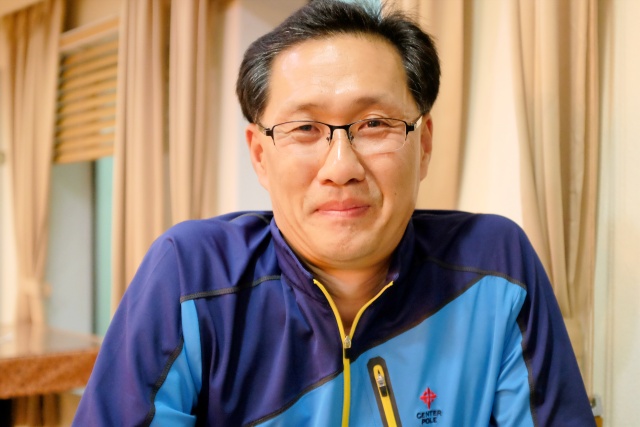
Ferry Jeju - Mokpo: I spent 3 hours in pleasant conversation on the ferry with this banker, Kim-GoyMin
I had a pleasant 3-hour chat with a very decent banker from NH. He had visited Jeju on business, but had also walked up Halla Mountain. We discussed everything from the Japanese and the Korean War to the rebellions in Gwangju. He was surprised by how much I already knew. I read at night in the tent on my Kindle and then I could show off.
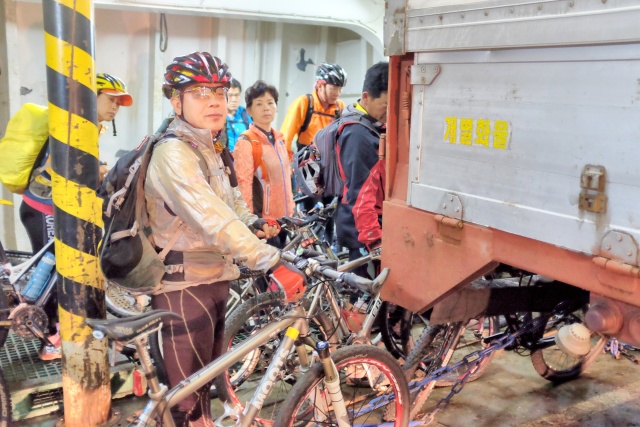
Ferry Jeju - Mokpo: Cyclists waiting for the ferry crossing

Ferry Jeju - Mokpo: Before we could get back on our bikes, we had to squeeze our way between moving trucks
This time I was not the one getting lost when looking for the bicycle. I stayed with a group of six cyclists, they were the ones who were lost. It was very awkward, we pushed ourselves through narrow gaps between the trucks and breathed in their stench. Unsuitable for claustrophobic people. Luckily we found the bikes before the ferry anchored in the harbor and pushed forwards to disembark with the first cars. It was 23:50. I entered the approximate location of the pavilion where I had slept the night before leaving for Jeju-do. At 0:45 I pitched my tent and at 01:15 I was sleeping contentedly.
